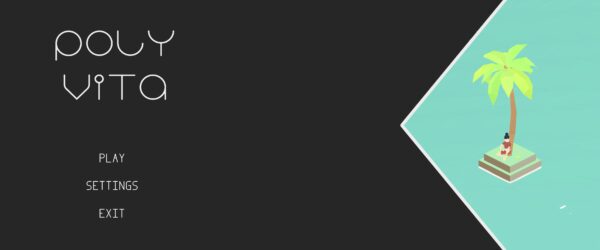There are many a good game I’ve played in my time, so many in fact that I’ve often forgot the ones that really meant a great deal to me when I played them. Today’s title, Poly Vita, reminded me of what a joy Monument Valley was and how I was missing that simplistic, mobile-first gameplay that was set to eat the world back in the day. Seeing Poly Vita, which obviously took some heavy inspiration both aesthetically and mechanically from it, felt like it had enough of the spirit of Monument Valley to make a look in worthwhile. It may not reach the incredibly high bar set by that title, but it’s enjoyable enough in its own right.

Poly Vita opens with a very short prologue saying that Maya, the game’s protagonist, has been trapped in a dream and needs to solve puzzles in order to collect all the fragments of her soul. Given this was likely designed to be a kind of casual puzzle game I’ll give the dev a pass here on not trying to attempt the same kind of visual storytelling that other games would have. Still it almost seems like those little bits of opening and closing exposition aren’t exactly necessary when all you’re doing is finding a path through an area whilst collecting items along the way. Perhaps there was an idea for more story elements to make a showing here, but I can imagine they were the first things to drop as a solo dev.
Quite obviously Poly Vita takes heavy inspiration from Monument Valley, using the same isometric viewpoint as well as the use of sharp geometry coupled with the same low-poly/no-texture aesthetic that every indie dev loves. In this regard the dev has done extremely well in capturing the same aesthetic essence that made those games great. Poly Vita does want a little for variety in environments however, most of the differences in levels coming from the slight changes in backgrounds and differing colour palettes. Again another limitation of being a single dev so it’s understandable.

Mechanically Poly Vita is a simple beast: have Maya collect all her soul fragments before making your way to the exit. You’re not free to roam everywhere however, instead you’ll have to connect paths using the tiles provided to you that’ll enable you to move between fixed points. Herein lies the challenge: being able to figure out which sequence of tiles and moves will allow you to get into the right places. As you’d expect the game doesn’t simply stay static in terms of the challenging mechanics it introduces to you, gradually ramping up the complexity over time. Like many similar puzzler games the concept of “easy to learn, hard to master” is very much at play here as whilst the game presents one problem, the achievements could drive you towards a much more challenging endeavour.
The mechanics are pretty easily understood as most of them are just a variant on different path blockers that need to be dealt with in order to move past them. Poly Vita takes a rather unusual step in demonstrating these to you by essentially giving you an extended tutorial on each one of them. Each of the different sections introducing a new mechanic, but only that mechanic. So this means that the puzzle difficulty resets every so often, getting a lot easier before the penultimate challenge for that particular mechanic.

The last rounds do make use of all the mechanics together however and, as you’d expect, those are the most challenging puzzles of all. Before then it was very much a mixed bag as for some of the mechanics the solution just seemed to come to me without even thinking about it, whilst there were a couple that really stumped me for no discernable reason. I did find that working backwards from the objective helped me quite a bit in terms of figuring out what moves I needed to make in order to get where I wanted to be. Other times I’d find myself just repeating the same moves over in slightly different ways until I figured out which order they needed to be executed in, sometimes missing a solution by one move and then retracing all my steps to see where I went wrong.
Funnily enough there are ways to break the game, but not in any way that’s advantageous to you. I found myself actually stuck a couple times, putting myself in a position where I was unable to move or even go back the way I came due to the way that the puzzle was created. I don’t think this was intentional though, as the game didn’t appear to know that I was stuck and couldn’t move. Thankfully you can simply retry the level to get back to square one, but that does hurt a bit when you’d were on the final section of a puzzle.

Poly Vita pays tribute to its inspiration well, capturing a lot of what made those games good whilst also working within the limits of what a solo developer can do. The visuals and mechanics are quite good, delivering the experience that I believe the developer set out to achieve. The sacrifices that need to be made as a solo developer are clear though, with variety of said mechanics and visuals being somewhat low. There’s also the complete lack of a narrative bar for a bit of opening and closing exposition, something that I feel could have been completely left out and not impacted the game at all. All in all I think this is a fantastic first release from Alejandro Zielinsky and I hope he’ll be able to keep pursuing a passion for game development going forwards.
Rating: 7.5/10
Poly Vita is available on PC and Android right now for $8.50. Total play time was 2.4 hours with 42% of the achievements unlocked.



